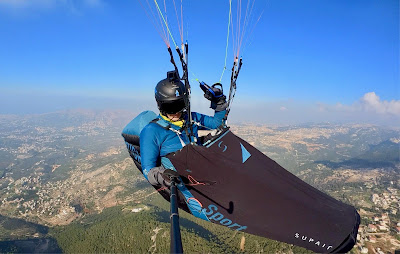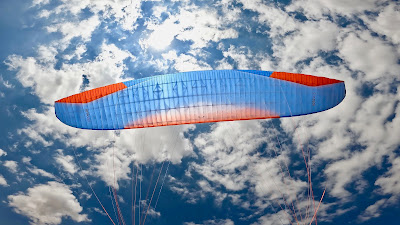I already reviewed the Delight 2 and 3. Here’s the fourth version with …finally a nicer aerodynamic look with a fairing.
When I flew the old Delight3 and as I always fiddle with my equipment after the test has been made, I made lots of adjustments, like inserting a foam from the upper part to reach the lower back and that made more support to my lower back with a comfortable sitting position and also rewired the line settings of the pod to reach a nearly no pressure on the tight and natural leg support while maintaining a correct pod alignment into the airflow. But the Delight 3 was targeted as a first pod harness with a good stability of its ABS system and also of its reclined position.
The Delight 4 has a seat board.
Now here’s the Delight 4 in the same M size I can confirm that they didn’t change the recommended size for the pilots. So the old D3 M size and the Delight 4 M size are targeted to the same pilot size.
The weight of Delight 4 is around 4 kg and similar to the D3 weight. The ABS system is exactly the same, but ….! to my surprise, SUPAIR has made the exact modifications I did on the Delight 3 to have much less pressure on the thighs and more comfort on the lower back, and nearly natural leg support in the pod, but also made lots of other things much more interesting that we will talk about.
At first, there’s a left attachment point to prevent slipping through the harness if by mistake the pilot didn’t buckle properly. This buckle SUPAIR said that it holds around 120 kg.
There’s a relief hole on each side of the pod. The instrument holder is now attached with a buckle that keeps it above the chest strap, if it contains heavy materials, and will prevent it to flip blocking your view. Now it will stay fit in place.
The zip that opens the instrument holder is in front which helps much more reaching into it. The zipper of the instrument holder of the Genie light 3 is on the back and I found it best to have it on the front side for accessibility.
The openings of the air inlets that inflates the fairing are smaller and softer than the ones on my X-rated 6. Those inlets have some plastic inserts that keep them in shape. On my X-rated 6, they broke a lot of times, and I couldn’t change them easily without a sewing machine… But on the Delight 4, they can be changed easily and the insert is made from a softer plastic material.
The harness has lots of adjustments comparing it to the D3, and they added a more efficient one for the hip position and comfort. The pod straps have 3 adjustments on each side to make a more refined tuning.
Of course, there’s also a place for the camelback with a pocket to insert it in the back. The main back storage seems really large. Larger a bit than the Genie 3 light, and larger than the Woody Valley GTO.
The back protection as you will see on their website is made from two parts in order to open the two parts for more compact packing.
With my 1.81m and 72 kg, I felt completely ok on the Delight 4, which is my size.
As I always mention, it is a super difficult job to describe or define comfort (for the back, hip…etc) for a certain harness, just because many pilots with the same height and weight have different leg or shoulder measurements.
Let's talk about the harness sizes first :
So for me personally I felt that the Delight 4 in M size has the same measurements as the ADVANCE Impress 4 M, Supair Delight 3 M, Ozone Forza M, GIN Genie race 4 M,
The Genie light 3 M felt very slightly smaller but I’m also just ok with it.
About back comfort and body pressure,
The Delight 4 has much better comfort for the body than the Delight 3. On the Genie 3 light, the legs are slightly more supported, and I think the ABS system on the Delight 4 cannot give you less pressure on the thighs and be efficient in roll movements. On the Impress 4 which is the most relaxing to sit in, the roll control for the little movements and feedback is not as precise as on the Delight 4 or Genie light 3 for example. For the 4 to 5 kg category harnesses, the Delight 4 is more comfortable to sit in than the WV GTO, M size for example.
Roll feedback and comfort in the air: From 1 as max roll and less comfort to 4 as max comfort and less roll.
1- Lightness 2, Impress 3
2-WV GTO, Forza, Genie 3 light, X-rated 6, Lightness 3
3- Impress 4, Genie race 4,
4- Delight 3, Delight 4
The Delight 4 has an ABS system that blocks higher roll movements. Some pilots would prefer it, others would prefer a much more roll-inducing harness like the Genie 3 light, or even more like the Lightness 2, etc… Each pilot has his own preferences.
I felt that pilots could add a small ball with an elastic band attached to the inside of the front pod foot holder, and that ball could be inserted on the shoe laces, in order to make it simple to enter the pod after take off.
Conclusion: Light, robust, practical, easy to pack good harness for traveling, good comfortable harness in strong air, looks nice in the air…and is nicely comfortable for the sitting position. That’s the Delight 4.
And surely, a test flight could be the best way for each individual to see if it fits his requirements.
https://supair.com/en/produit/sellette-supair-delight4-sport/



























